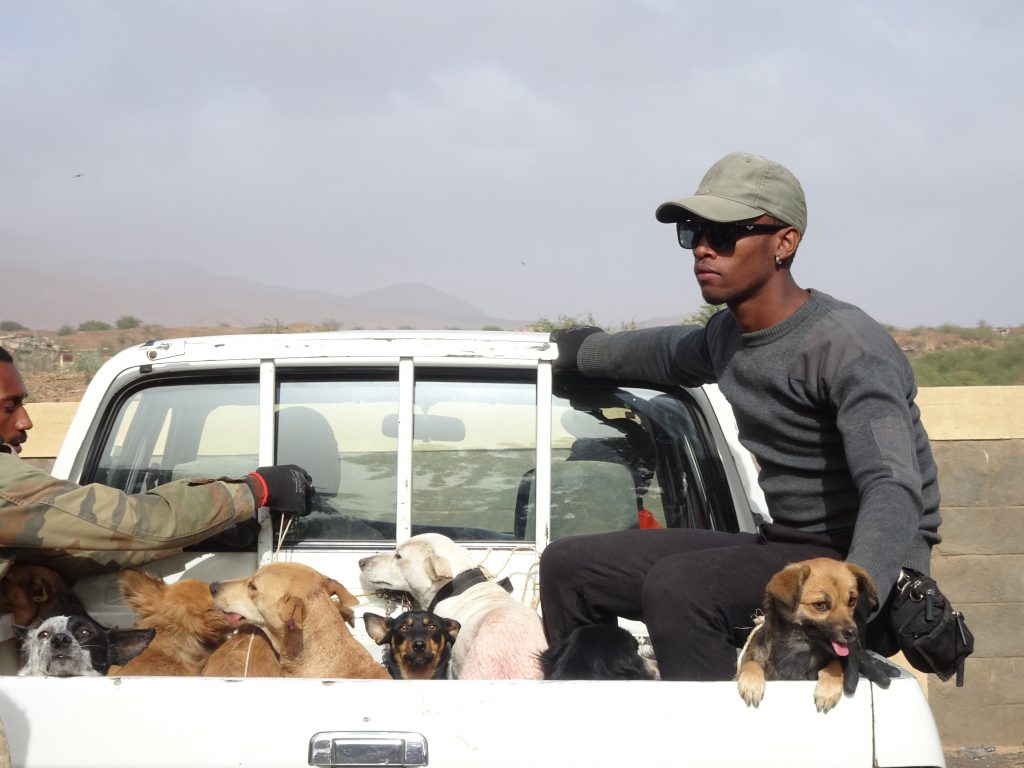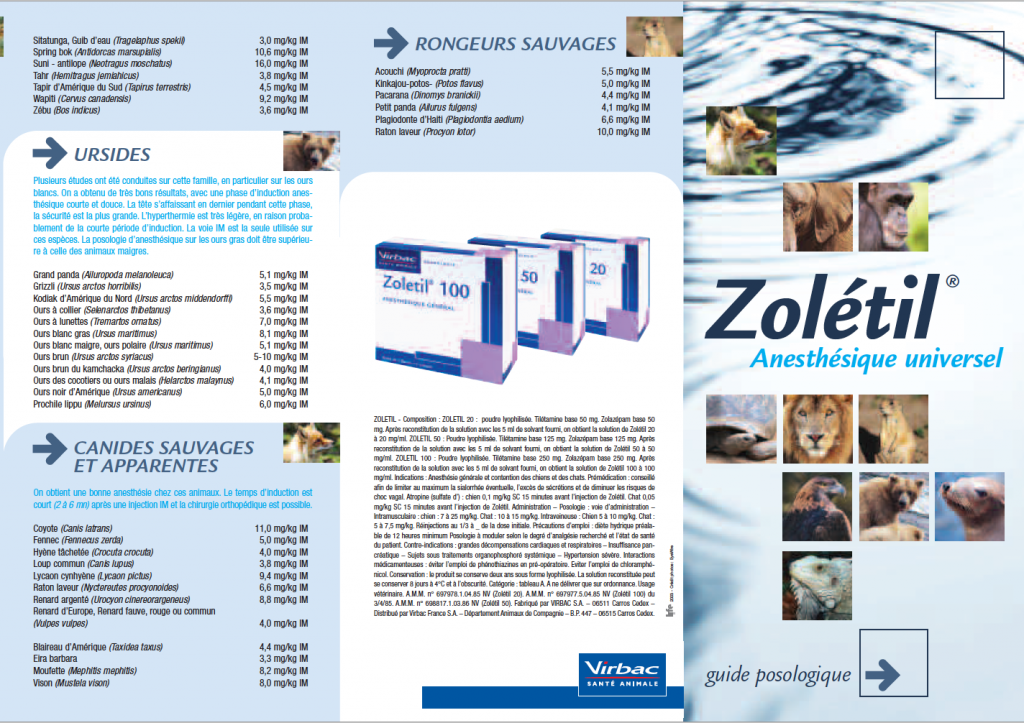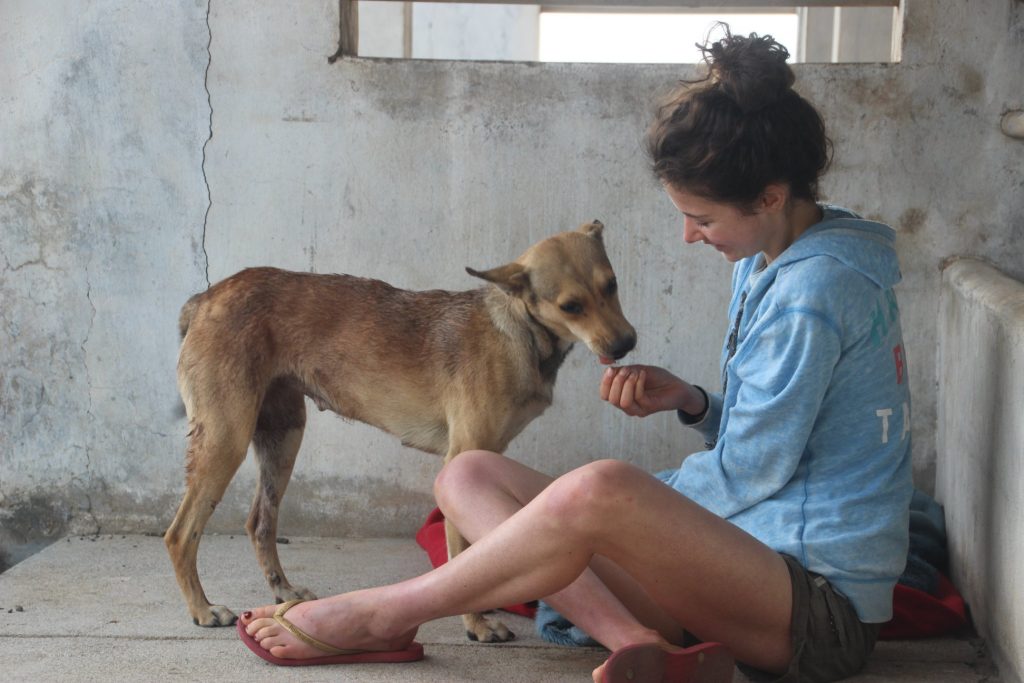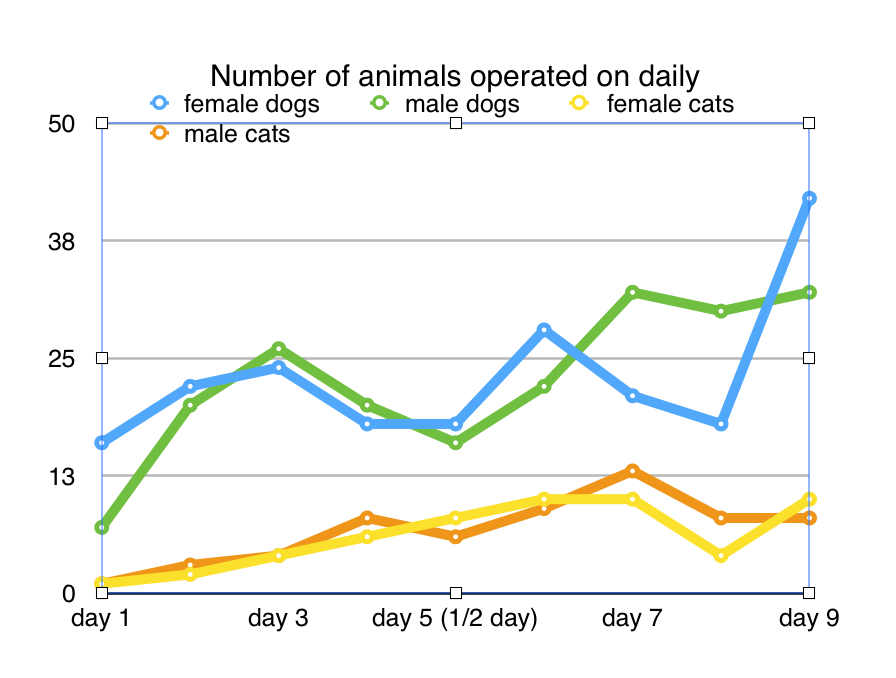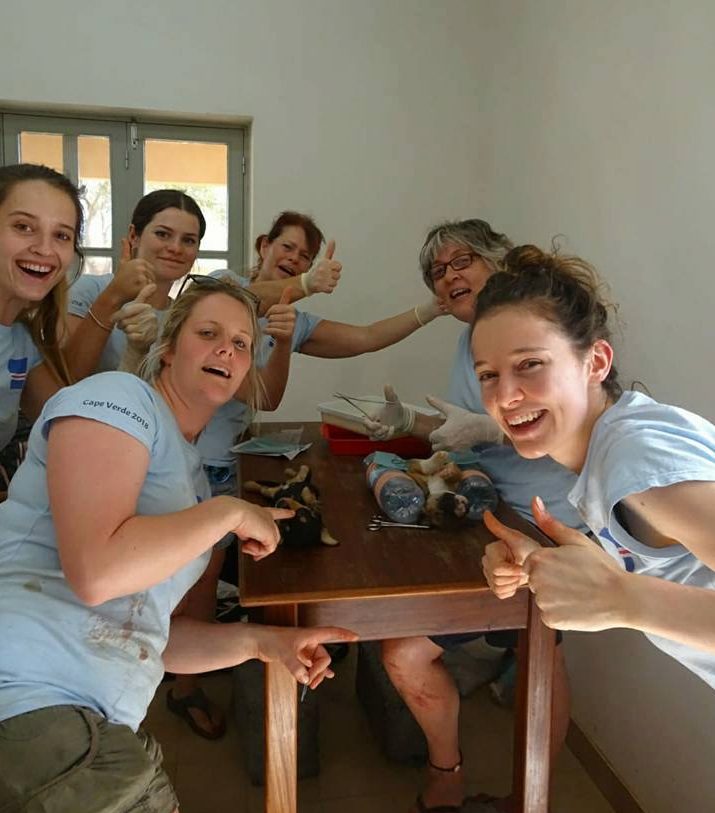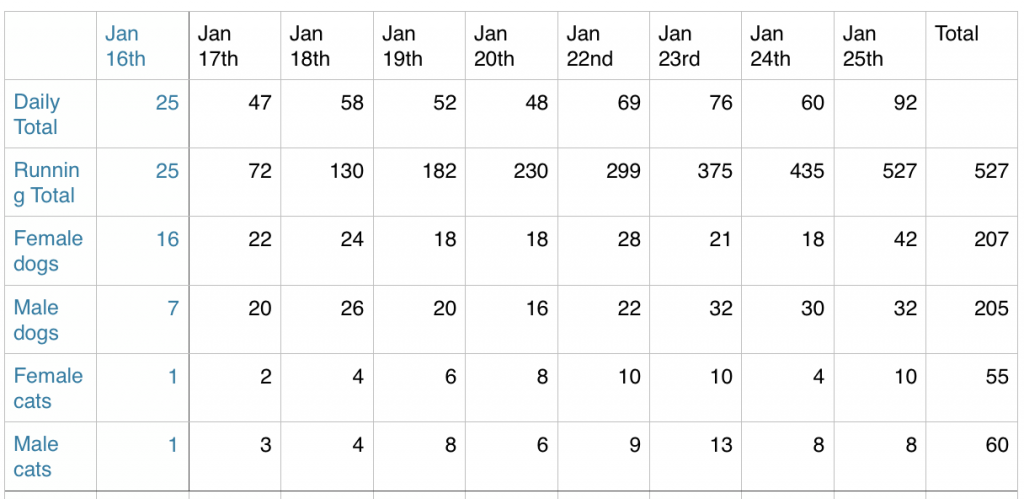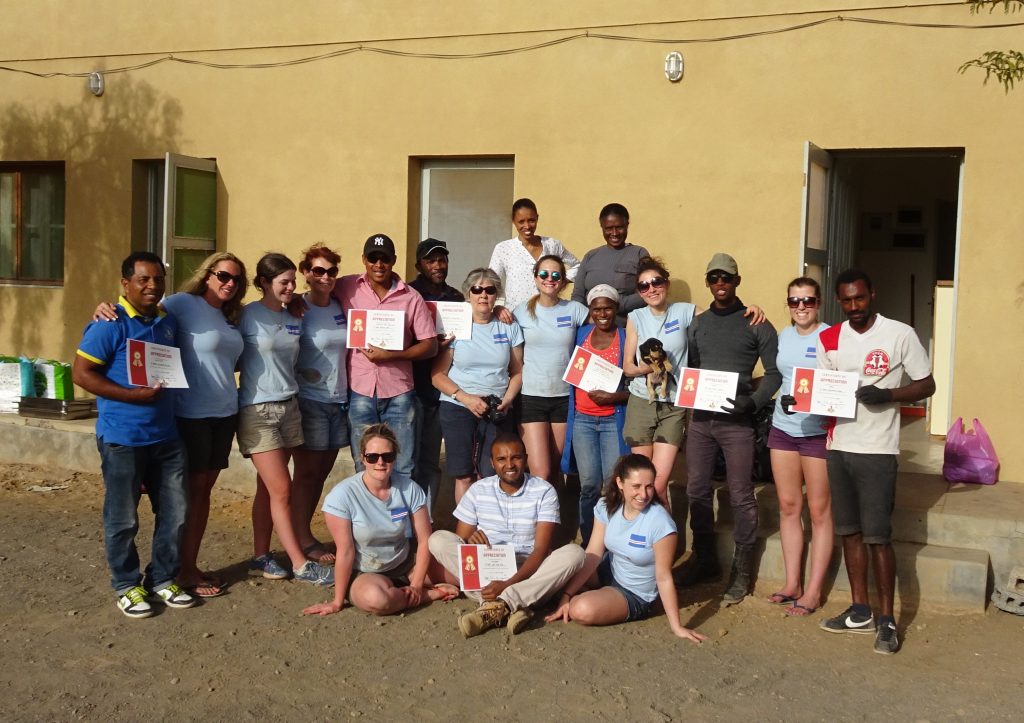SPAY SISTERS CAPE VERDE 2018
So the actual trip started for most of us on Sunday 14th January. I had spent the previous two weeks in an absolute turmoil, faced with a myriad of problems due to the possible consequences of drug trafficking, the lack of written confirmation concerning accommodation and unfortunately Toni-Marie at the last minute falling sick with a hooping cough!!
However, despite the uncertainties and in true Spay Sisters style the trip wasn’t cancelled. Some of us met at the Stansted airport to share luggage. Suzy flew in from Kuwait and joined us in Lisbon airport. While Phoebe and Anna, unknown to the majority of us, vet students met us at the visa booth in Saint Vincente arrivals. Jill, the final warrior, was waiting for us at the Saint Vincente port where we caught the boat to Sao Antao. To what we were going to arrive, other than a definite Portuguese-English language barrier, we didn’t know. At the last minute, due to Toni not coming, Tess, my daughter joined us, which though Spanish isn’t Portuguese, they did seem more able to understand her than the rest of us!
The boat docked and despite studying the quay, there didn’t seem to be anyone, that looked as if they would be meeting us. Though we had had email contact with Irlando finally on the Tuesday before we left, we had taken sleeping bags in case. The countryside looked barren and volcanic, the weather was warm, but the wind was impressive. So we wandered through the port buildings along with the rest of the people who had been on the boat and looked around. It was very busy as people met friends and family, jumped into taxis or cars and disappeared.
We were attracting a bit of attention, nine white women, but we were left alone after the taxi drivers had understood we were not interested. So still with no idea, who we were meeting or where we were going to be taken if indeed we were, action was needed. Approaching a man I said ‘Do you know Irlando Ramos?’ He seemed to get the idea and started babbling away into his telephone. He didn’t have the number, but he knew someone who did! The result was we were told ‘meetings, meetings, later’ In the end, we were left waiting under an hour, before Irlando arrived, greeted us, waved a hand for a taxi to come and we were driven off in two vehicles to a very nice looking hotel. Everybody was very relieved, the accommodation for the trip was going to be fine….there was even a hotel pool!!!
Irlando, then let us get organised, it was Monday evening, before returning to have a meeting with us, and then the President even arrived to welcome us. Information was exchanged about where we would be working, where we would be eating our evening meals, and at what time the Taxi would be arriving, 8.30am for us to start work.
They had never had a veterinary charity working on their island before so they didn’t know how it would work but they had put some men at our disposal for catching the dogs and cats.
Viviene is their local ministry vet, who thankfully spoke English and whom we met the following morning when we arrived at the Centro Caprino de Cha de Italia, where we worked. Relaxing now with the accommodation and food organised we soon had our next worry, how was our anaesthetic protocol going to work.
We have always used the ketamine, domitor and butorphanol up until this year. However, Ketamine is now becoming very difficult to get, and it is becoming very carefully controlled, due to its use in the party scene. So the alternative we decided to try was Zoletil, though none of us had ever used it before. The other problem with Zoletil is that there are no combination drug charts. We rang Virbac to enquire, and they sent information on how to anaesthetise animals and also a chart on drug doses for all sorts of exotics!
So we decided we would start with the lowest dose of the drug, and the vets with the most experience and see what happened. Suzy was obviously the most involved with this as she was doing the majority of the nursing while Toni and Tess’s job was catching and prep’g. Our first animals did, in fact, take a long time to wake up, still being asleep 3 hours after the operation. The doses of Zoletil were decreased, and we used the combination chart replacing the Ketamine, with a markedly lower dose of Zoletil, however, combining it with the weight-specific domitor and butorphanol. After 527 anaesthetics, we unfortunately had a cat castrate that died. A 12wk old puppy which we were spaying, worried us as she went into apnoea, we then tubed her, gave her some antisedan and she woke up without consequences. However the dogs wake up calmer, with fewer animals fitting post operation. So we all agreed that we would use the drug again in preference to Ketamine in future trips (despite the increased cost).
Having had lizzy and Amy as vet students last year in Mozambique, I ended up being a bit blase with Anna and Phoebe. I paid them less attention and expected them to be able to get on with it and do it. Again it all went well, with the typical problems of inexperience and knowledge of what is a tight ligature and how much tissue can you tear. The other difficulty surgery wise is that the dogs were covered in ticks, therefore surely carrying ehrlichia, babesia etc…causing them to bleed a lot.
One of our most memorable stories was this stray bitch that had been found at the beach. She was laid in front of Anna to spay, so Anna got her equipment organised, put on her drape, with drape clamps and did her first skin incision. Suddenly with no warning, the bitch leapt off the table, landing the large stone which had been holding her in place onto Anna’s foot, whilst running out of the room, literally entirely conscious!! We all screamed, and she then got recaught by Suzy before leaving the grounds, and re anaesthetised. Anna then restarted operating and naturally, it became a nightmare, she was bleeding too much. Anna was unsure of her ligatures, I got called in. Yes, she was bleeding a lot, so Anna finished the operation, we put her on a drip, reversed the domitor and woke her up as quickly as possible. She seemed fine, she woke up, we all breathed in relief and got back to our following surgeries. Then she started bleeding from her wound, staggering around dripping rapidly. We didn’t have any bandages; they didn’t have any bandages either, so we tied swabs together got a huge piece of cotton wool and strapped it around the dog. When we finished our working day, it was decided that we would leave this dog in the pound and either she would be ok or not the following morning. She was fine the following morning, and this picture tells the story.
After the 4.5 days, we had already done 178 animals and were amazed at the number of dogs, with people bringing their own dogs. Ownership of dogs isn’t the same as in Europe, but the locals definitely liked their dogs, they bought them to be operated on and then waited for them to wake up to take them home again. Toni and Tess then intermittently disappeared with Roni and Mario to catch and bring back more dogs in the pickup. We were also surprised at the number of female dogs, and there weren’t many cats.
The second week we were more in the swing of things, the music was blaring all the teething problems were out of the way, and even Lizzy had calmed down!! We were only working for four days with us going to Center of rural development of Ribeira das Patas on Wednesday to work in what seemed the Mairie of a pretty small village. Before arriving, we had written to Irlando to tell him we estimated being able to sterilise 350 animals in our time there and we wanted to achieve the numbers especially as the accommodation and food were excellent, and everybody was so friendly to us. At the end of our working day on Tuesday we had already reached 375 animals, and thankfully our drugs hadn’t run out. Every animal operated on was getting an anaesthetic combination including a narcotic. They were also getting a long-acting antibiotic jab and a nsaid, with the majority even getting a shot of ivomec.
The last day involved Jill hitting the 100 animals neutered though she had already been out the night before to celebrate!!
Suzy still had the energy to do the maths after a fantastic score of 92 animals operated on to tell us we had done 527 animals in all and Motta, who started the sejour as Michel agreed. We were all very happy and very tired, but we held a little ceremony and gave out awards to the workforce of drivers, catchers, cleaners, Viviene and Irlando who had made it all happen.
Drugs used: Zoletil 100mg 5ml bottle x 15 Meditomidine 50ml x 4 Dolorex 10ml x 8 Meloxicam x 100ml x 3 Shotapen x 250ml x 2 Amoxycillin x 100ml x 1 Ivomec x 250ml x 1 Adrenacaine x 100ml x 1
So after another successful Spay Sisters trip we must also thank the people who didn’t come but contributed. We were lucky enough this year thanks to Toni Cobbett to get a very generous donation from Mr Peter Cullimore, whom we will be sincerely in love with if he wishes to continue to sponsor us next year! Also David Eagar, who allows us to buy our equipment, draps and syringes etc.. through his surgery Elmhouse Vets, Chelmsford. Koen Goovaerts and Monica for allowing me to purchase the drugs through the Cabinet Veterinaire de St Pons. The University of Bristol for providing us with a lot of sterile gloves brought along in Phoebe and Anna’s suitcase. And lastly all the employers that allowed their employees to come away on the adventure.
Now in Portuguese:
SPAY SISTERS CAPE VERDE 2018
Para a maioria das Spay Sisters, a viagem começou no domingo 14 de janeiro.
Passei as duas semanas anteriores numa turbulência absoluta, perante uma miríade de problemas: as possíveis consequências do tráfico de fármacos, a falta de confirmação por escrito do alojamento e, infelizmente, a doença de Toni-Marie, que no último instante ficou com uma tosse aguda!
No entanto, apesar das incertezas e ao verdadeiro estilo de Spay Sisters, a viagem não foi cancelada. Algumas Spay Sisters encontraram-se no Aeroporto de Stansted para distribuir a bagagem. A Suzy voou do Kuwait e juntou-se a nós no Aeroporto de Lisboa. Enquanto isso, a Phoebe e a Anna, estudantes veterinárias desconhecidas para a maioria de nós, encontraram-se connosco no departamento de vistos das chegadas a São Vicente. Jill, a guerreira final, estava à nossa espera no porto de São Vicente, onde fomos de barco para Santo Antão. Não sabíamos muito do que nos esperava, além de uma barreira linguística absoluta, entre a língua portuguesa / inglesa. No último momento, devido à Toni não se poder juntar ao grupo, Tess, a minha filha, que fala espanhol, juntou-se a nós. Embora o espanhol não seja português, pareceu-nos que as pessoas em Cabo Verde eram bem mais capazes de a compreender do que o resto de nós!
O barco atracou e no cais não havia ninguém à nossa espera. Embora tivéssemos sido contactadas por e-mail, na terça-feira antes, pelo Irlando, que nos garantiu que estava tínhamos alojamento garantido, levamos sacos cama. A paisagem parecia estéril e vulcânica, o clima era quente, e o vento impressionante. Vagueamos pelos edifícios portuários juntamente com os amigos e familiares que se encontravam, apanhavam um táxis, ou os seus próprios carros, e desapareciam.
Atraíamos um pouco de atenção pois éramos nove mulheres brancas juntas, mas os taxistas deixaram-nos em paz assim que entenderam que não estávamos interessadas. Assim, sem a menor ideia de com quem estava a falar ou onde isso nos iria levar, aproximei-me de um homem, e disse: “Conhece Irlando Ramos?” Ele pareceu ter ideia de quem era e começou a balbuciar ao telefone. Ele não tinha o número dele, mas conhecia alguém que o tinha. O resultado é que fomos informados de “reuniões, reuniões, mais tarde”…
Ficamos à espera cerca de uma hora, até que Irlando chegasse. Cumprimentou-nos, chamou um táxi e fomos conduzidas em dois veículos para um hotel muito agradável. Ficamos muito aliviadas por saber que tínhamos alojamento e tudo ficaria bem… Havia até uma piscina no hotel!!!
Irlando deixou-nos à vontade para nos instalarmos e voltou na segunda-feira à noite para uma reunião onde até o Presidente nos recebeu. Formos informadas sobre o local de trabalho e o local de jantar, e ainda sobre a que horas chegaria o táxi (às 8h30) para começarmos a trabalhar.
Nunca tinham tido uma instituição de caridade veterinária a trabalhar nesta ilha, logo não sabiam como funcionaria, mas colocaram alguns homens à disposição para apanhar os cães e gatos das ruas.
Na manhã seguinte, Viviene, a veterinária local, encontrou-se connosco no local de trabalho – o Centro Caprino de Cha de Italia, e felizmente falava inglês. Agora que estávamos descansadas com o alojamento e refeições organizadas, tivemos logo a próxima preocupação, como funcionaria o protocolo de anestesia.
Usamos sempre a Ketamina, o Domitor e o Butorfanol. No entanto, a Ketamina está-se a tornar muito difícil de obter e cuidadosamente controlada, devido ao seu uso para consumo de drogas. A alternativa foi tentar o Zoletil (embora nenhuma de nós tivesse usado antes). O outro problema com o Zoletil é que não há gráficos de drogas combinadas. Contactamos o laboratório Virbac para pedir informações e eles enviaram-nos um gráfico com as doses para todos os tipos de animais, inclusive exóticos!
Decidimos que começaríamos com a dose mais baixa e com os veterinários mais experientes para ver como corria. Suzy foi, obviamente, a mais envolvida no trabalho de enfermagem enquanto a Toni e a Tess seguravam e preparavam os animais. Os nossos primeiros animais demoraram muito tempo a acordar, e dormiam até 3 horas após a operação, logo as doses de Zoletil foram diminuídas. Usamos a tabela de combinação de fármacos que substitui a Ketamina, com uma dose marcadamente mais baixa de Zoletil, no entanto, combinando-a com o domitor (específico do peso) e o Butorfanol.
Infelizmente após 527 anestesias tivemos um gato que foi castrado e que morreu. Houve também um cachorrinho de 12 semanas que esterilizamos, que nos preocupou pois entrou em apneia. Procedemos à entubação demos-lhe algum antisedan e ele acordou, felizmente, sem consequências. No entanto, constatamos que os cães acordam mais calmos após a operação. Concordamos que usaremos novamente o Zoletil em vez da Ketamina, em viagens futuras (apesar do aumento do custo).
Tendo tido a Lizzy e a Amy como estudantes de veterinária, o ano passado em Moçambique, suponho que fui um pouco culpada de prestar-lhes menos atenção este ano, e esperei que fizessem as cirurgias sem grandes complicações. Novamente tudo correu bem, com os problemas típicos de inexperiência e do conhecimento do que é uma ligadura apertada e quanto tecido se pode ou não rasgar. A outra dificuldade em termos destas cirurgias é que os cães estavam cobertos de carraças, portanto, seguramente carregados de parasitas como a ehrlichia, babesia etc … o que os fazia sangrar muito.
Uma das nossas histórias memoráveis foi uma cadela que tinha sido encontrada na praia. A Anna organizou o equipamento para a esterilizar e fez uma primeira incisão na pele. De repente, sem aviso prévio, a cadela saltou da mesa, empurrando a pedra grande que a segurava, para cima do pé da Anna, enquanto corria pela sala inteiramente consciente! Nós ficamos em pânico, até que a Suzy a agarrou e a voltou a anestesiar. A Anna reiniciou a cirurgia que, naturalmente, se tornou um pesadelo, pois esta cadela sangrava imenso. A Anna não tinha a certeza que as suas ligaduras estavam bem, e eu fui convocada. Sim, a cadela sangrava muito de facto, então a Anna terminou a operação, e colocamos-lhe soro. Revertemos a anestesia e tentamos acordá-la o mais rápido possível. Parecia-nos bem e quando acordou, todas respiramos aliviadas e voltamos às nossas cirurgias. A cadela começou a sangrar da sua incisão, cambaleando em torno do soro. Não tínhamos grandes pensos; eles também não tinham bandagens, então com vários materiais e um enorme pedaço de algodão, colocamos um penso compressivo na cadela. Quando terminamos o nosso dia, foi decidido que esta cadela ficaria em observação até ao dia seguinte. Ela estava bem na manhã seguinte e esta imagem conta a história.
Após 4/5 dias, já tínhamos esterilizado 178 animais e ficamos maravilhadas com o número de cães trazidos pelas pessoas que os tinham em casa. A detenção de cães não é como na Europa, mas os habitantes locais gostam, definitivamente, dos seus cães. Eles levavam-nos para serem operados e depois esperaram que acordassem para levá-los de volta a casa novamente. Toni e Tess ajudavam Roni e Mario a trazer cães de volta, na pickup. Nós também ficamos surpreendidas com o número de cães do sexo feminino. Não havia muitos gatos.
Na segunda semana, as coisas fluíam melhor, a música tocava e todos os problemas estavam longe, inclusive a Lizzy se acalmou!! Nós trabalhávamos apenas mais quatro dias neste local.
Na quarta-feira seguinte iríamos para o Centro de Desenvolvimento Rural da Ribeira das Patas para trabalhar naquilo que parecia ser uma câmara municipal de uma pequena aldeia. Antes de lá chegar, escrevemos ao Irlando para lhe dizer que estimávamos ser capazes de esterilizar 350 animais, durante a nossa estadia. Queríamos alcançar esses números, especialmente porque a acomodação e comida eram excelentes, e todos nos tratavam tão bem :).
No final da nossa terça-feira, chegamos aos 375 animais, e, felizmente os nossos fármacos não acabaram. Todos os animais eram operados com uma combinação anestésica, incluindo um narcótico. Também recebiam antibiótico de ação prolongada e um anti-inflamatório não esteróide. A maioria dos animais recebeu também uma injeção de ivomec.
Os acontecimentos do último dia envolveram a Jill atingir o recorde de 100 animais esterilizados, (embora tivesse saído na noite anterior para celebrar)!!
A Suzy, depois que um fantástico dia de 92 animais operados, teve ainda energia para fazer as contas e nos dizer que esterilizamos no total 527 animais! Estávamos todas muito felizes e muito cansadas, mas realizamos uma pequena cerimónia onde concedemos prémios às forças do trabalho – os motoristas, os coletores, os limpadores, à Viviene e ao Irlando que tudo fizeram acontecer.
Drogas usadas: Zoletil 100mg Garrafa de 5ml x 15Meditomidina 50ml x 4Dolorex 10ml x 8 Meloxicam x 100ml x 3 Shotapen x 250ml x 2 Amoxicilina x 100ml x 1 Ivomec x 250ml x 1 Adrenacaína x 100ml x 1
Depois de mais outra viagem com sucesso das Spay Sisters, também devemos agradecer às pessoas que não vieram, mas contribuíram. Este ano tivemos a sorte do nosso lado, graças à Toni Cobbett que recebeu um donativo muito generoso do Sr. Peter Cullimore, a quem estaremos eternamente gratas se desejar continuar a patrocinar-nos no próximo ano! Também queremos agradecer a David Eagar, que nos permitiu comprar os equipamentos, fármacos e seringas, etc. através do seu centro de cirurgia Elmhouse Vets, Chelmsford. Agradecemos também a Koen Goovaerts e à Monica por me permitir comprar medicamentos através do Gabinete Veterinaire de St Pons. Obrigada à Universidade de Bristol que nos forneceu muitas luvas estéreis trazidas na mala de Phoebe e Anna. Finalmente, um obrigada a todos os chefes que permitiram que os seus funcionários se juntassem a nós nesta aventura.

